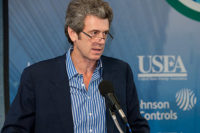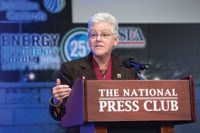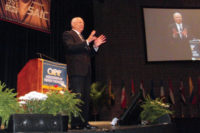Ann Elsen, C.E.M., energy consultant, ICF International, started the session by providing an Energy Star update, noting “There’s a lot more sense of urgency in energy efficiency.”
Energy represents 30 percent of a building’s operating costs, said Elsen. Pursuing the Energy Star label can save on those energy costs. She noted that the Energy Star label has been awarded to 3,200 buildings and “saves $600 million annually in lower energy bills.”
Elsen said that you can use an Energy Star rating to:
• Establish a building performance baseline;
• Identify opportunities for improvement;
• Check performance over time;
• Prioritize investment opportunities; and
• Get recognition if you achieve the Energy Star label.
The Energy Star program provides useful financial tools, she related, including: a financial value calculator that helps convert energy data into information usable for budgeting decisions; a cash flow opportunity calculator that answers questions about efficiency investments; and a building upgrade value calculator that provides return on investment.
A building upgrade manual is available that provides a third-party resource to validate upgrade decisions. Elsen said that users can easily achieve 10-20 percent energy savings with an 18-month payback.
RETROCOMMISSIONING
Barry Abramson, P.E., senior vice president, Servidyne Systems Inc., discussed opportunities through retrocommissioning.A study of energy intensity in Energy Star buildings found that “there is about a 35 percent difference compared to standard buildings,” said Abramson. Building owners have achieved the Energy Star label through retrofit programs. But some have retrofitted and still haven’t qualified, he said.
Age of equipment is not a significant predictor of how much energy a building uses, stated Abramson. And although 80-plus percent of Energy Star buildings have energy management systems, a lot of the worst performing buildings also use them.
Retrocommissioning is applied to existing buildings to enable a facility to meet the owner’s current and anticipated future requirements, he said. There are three laws of retrocommissioning.
The first law, as Einstein said, is “Everything should be made as simple as possible - but not simpler.”
The second law, as Gilbert and Sullivan noted, is “Things are seldom what they seem.” The third law, paraphrasing movie character Napoleon Dynamite, is “It may not be low-hanging fruit, but it’s still flippin’ sweet.”
There are problems that you can find in retrocommissioning. These include such things as the need to adjust outside air, mitigate simultaneous heating and cooling, reduce flow from oversized pumps, and reset supply air temperatures.
Is retrocommissioning more suitable for older buildings? According to Abramson, it is “pretty much suitable for every building.” Even newer buildings can have problems.
TRACKING IMPROVEMENTS
Greg Coleman, vice president of energy services, TRC Energy Services, then talked about tracking energy performance improvements.Where do you start to improve energy performance? Intuitively, Coleman said, people think they should start with the oldest buildings, the biggest buildings, buildings with the longest operating hours, or buildings in the harshest climate. However, there are no correlations based on any of these parameters, he stated. “You can’t be just intuitive.”
Coleman noted, “To quote Deming, ‘You can’t manage what you don’t measure.’” Energy Star benchmarking enables you to enter your building into the Portfolio Manager and see how it compares on a scale to other buildings of its type.
Coleman then explained how New York State’s K-12 schools program made use of the Portfolio Manager to measure and track its energy performance. The schools were able to achieve a 13 percent decrease in overall energy consumption; a 19 percent decrease in heating fuel consumption; and no increase in electricity consumption despite a 100 percent increase in air conditioning use.
STRATEGIES FOR SCHOOLS
Douglas Karnuth, C.E.M., program consultant, Schools for Energy Efficiency (SEE) Program, Hallberg Engineering Inc., closed the session with a presentation on energy-reduction strategies for schools.The SEE program that Karnuth works on is designed to help K-12 schools save energy. Goals are to reduce energy use by 10 percent; engage students, teachers, and staff through active participation; and achieve recognition through Energy Star. The program provides a basic step-by-step plan to save energy and heighten energy awareness. It is a five-year program. “The first three years are the core in creating sustainability in the program,” said Karnuth.
SEE schools are required to become Energy Star partners. School districts use Portfolio Manager to enter their energy data to rate their buildings. This helps the schools to improve their energy performance.
Initially, some schools thought they were already doing well regarding energy use and improvement wasn’t that significant. After all schools bought into the program, “Improvement was almost exponential,” Karnuth proclaimed.
Recognition for the schools for their achievements is very important, he said. Twelve districts have earned the Energy Star Leader Award and 72 schools have attained the Energy Star label. The SEE program has grown and is now approaching 400 schools participating in the program.
Karnuth then presented the energy-saving numbers. Reduction in energy use has ranged from 10-20 percent. Energy cost avoidance is $7.4 million. Average return on dollar invested is $2.68.
For more information, visit www.seeprograms.com.
Publication date:11/12/2007







